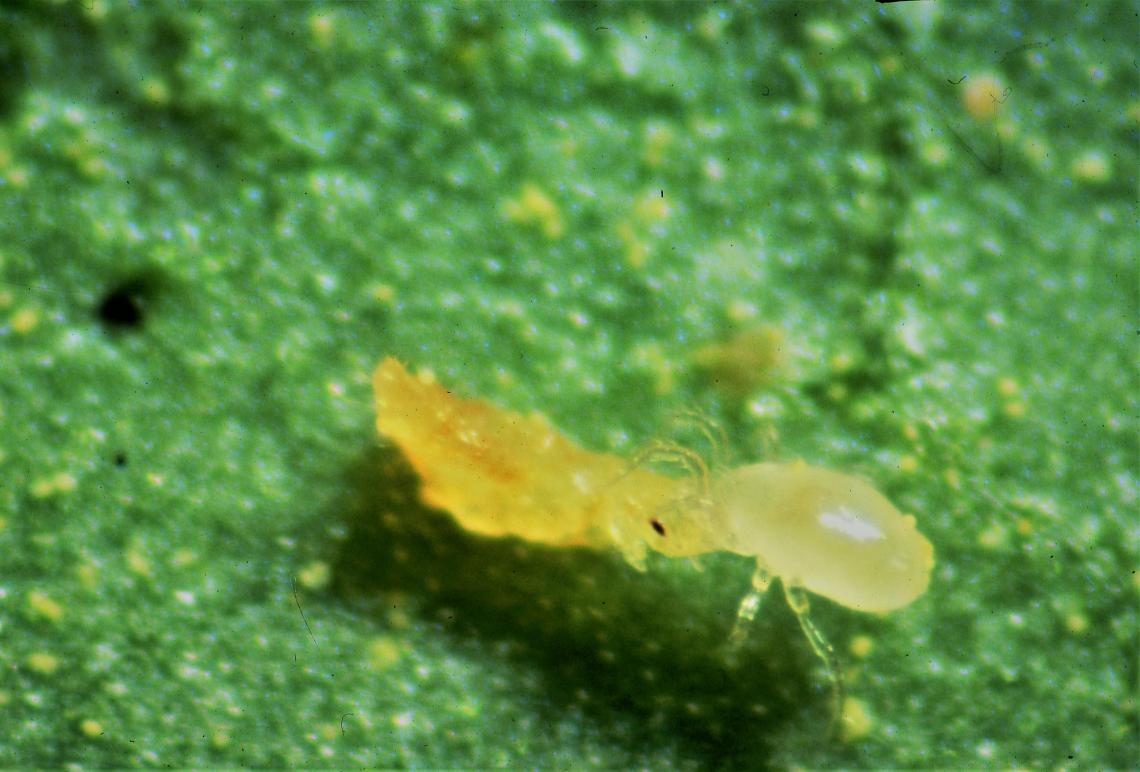Monty Typhlodromips montdorensis
Typhlodromips montdorensis (Monty) preys upon many small arthropods and pollen. They are mainly used to control whitefly and thrips but can also be used to aid the control of eriophyid and tarsonemid mites.
Monty is a subtropical species first discovered in southern Queensland by Marilyn Steiner in 1994 during a project funded by Horticulture Australia. Biological Services first commenced rearing Monty in 1994. At that time, we were able to rear Cucumeris more easily and in much higher numbers, so Monty was shelved. More advanced rearing methods have allowed Monty to be produced reliably in greater numbers. These predators have the advantage of being able to suppress whiteflies and thrips given the right conditions.
Description and life cycle
Monty are small pear-shaped predatory mites. They are generally pale in colour but this can vary depending on what they are feeding on. Their eggs are clear and oval and are generally laid on the underside of leaves on leaf hairs, or in protected areas under the sepals of flowers or the calyx of fruit. At 25oC, Monty take 6-7 days to complete their lifecycle. An adult predator consumes an average of 14 thrips larvae per day, feeding on both first and second instar prey.
Suitable crops and conditions
Monty is generally used to control whitefly and thrips in greenhouses. It is ideally suited to use in capsicums, cucumbers, eggplant, green leaf crops, flowers and ornamentals. Optimum temperature ranges are 20-30oC and egg hatching is enhanced if humidity is 70 per cent or greater.
It can also be used in outdoor crops in humid areas, provided temperatures do not remain below 12°C for extended periods as it is not active below 11oC. Where cooler temperatures are commonly experienced, Cucumeris or Lailae will perform better.
When to release
Monty is best used early in the crop cycle to prevent the build-up of whitefly and thrips. It establishes best on pollen-producing crops such as capsicums, as the pollen provides an alternative, high-quality food source for the mites. Where pollen is not present, several releases at regular intervals are often needed to keep predator numbers high or sachets could be utilised. For thrips control, Monty can be used in conjunction with Hypoaspis, Dalotia, Orius and Cucumeris. For whitefly control, programs can incorporate Encarsia, Eretmocerus (warrae or hayati), Lailae or Nesidiocoris depending on the crop and situation.
How to release
Loose material. Monty is supplied as a breeding culture in a vermiculite carrier which includes a food source. They can be easily sprinkled over leaves in the upper canopy of the crop. Try to release lightly and evenly throughout the crop to cover as many plants as practically possible.
Sachet. Hold sachets by the cardboard hook to avoid damaging any mites inside. Hang sachets in a shaded position out of direct sunlight if possible. In fast-growing vine crops such as cucumbers, place sachets close to the growing point on the first fully expanded leaf. Otherwise the sachet will be removed at de-leafing prior to its useful lifespan. For slower-growing crops, it is best to hang the sachet lower down in a protected position.
Release rates
Loose material. Monty is supplied in a media with a minimum of 100,000 predators per litre. For preventative releases, use 10-20L/ha and repeat several times at 2-3 week intervals depending on the crop. Higher rates may be required where pests are already established.
Sachet. Release 5000 sachets/ha every 6-8 weeks for preventative control. Release 10000/ha every 4 weeks for curative control or combine with high volume loose material releases.
Chemical use
Monty is sensitive to many pesticides, particularly pyrethroids, organophosphates and neonicotinoids. Residues on foliage and greenhouse structures may remain toxic for many weeks and negatively impact on their survival and ability to effect control. Check side-effects charts carefully and avoid using pesticides before and during Monty use unless they are known to be safe. Contact Biological Services for specific information.
Ordering and accounts
Orders are sent via express courier services on Monday or Tuesday of each week, and usually arrive within a couple of days. Orders received after noon on Tuesday are sent the following Monday. Prices are on a sliding scale i.e. the more that is purchased over a monthly period, the lower the price will be per unit. Freight is charged at Express parcel cost. Accounts are sent at the end of each month, and can be paid by EFT, BPay, cheque or postal order.





